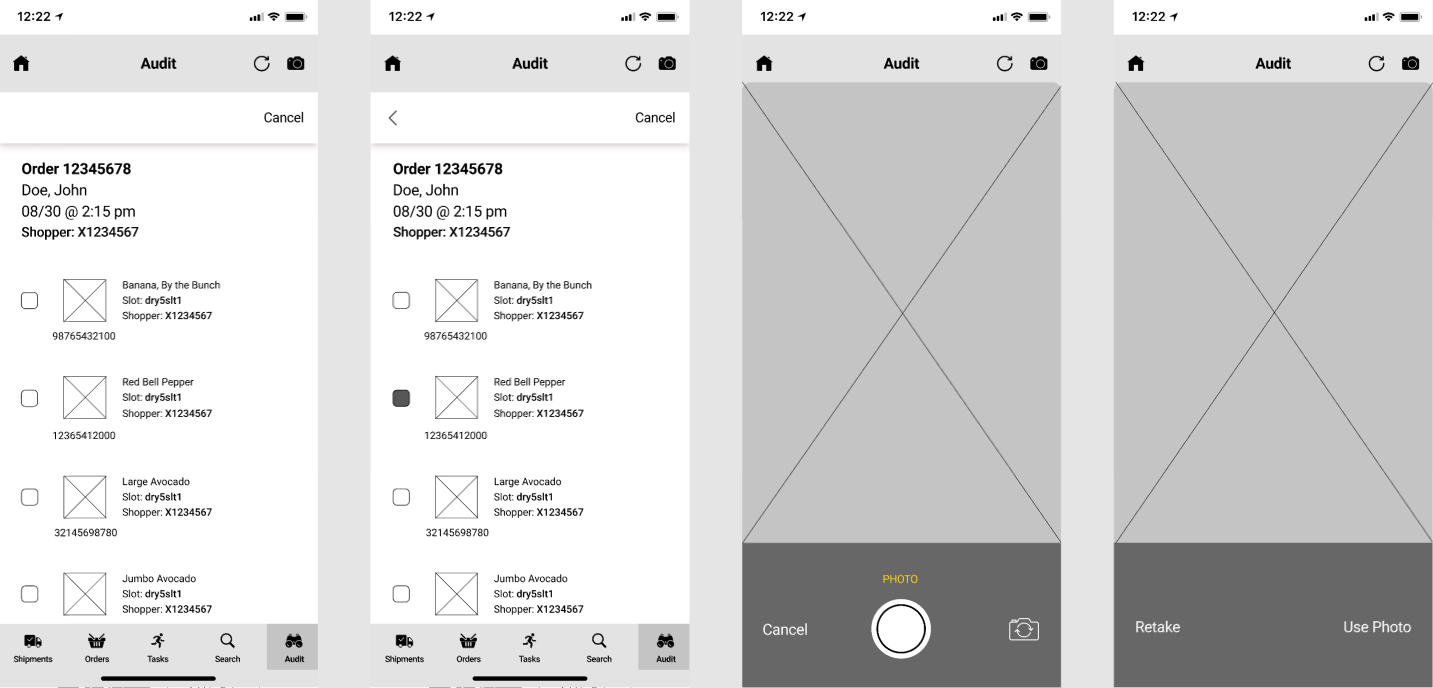What is the audit feature?
While working for a grocery store curbside department, recurring complaints were produce quality and damaged or missing items. The team audits carts to catch any mistakes, but communication with leadership can be lacking, especially during busy times.
This results in leadership missing the opportunity to coach shopping partners about any issues. The audit feature allows curbies to communicate efficiently so leadership can coach shopping partners regarding their performance.
Role
Sole UX designer
Key skills: secondary research, sketching, wireframes, prototyping and user testing, high fidelity mockups
Duration: 3 months
Project goals
Streamline communication between partners and leadership
Increase customer satisfaction.
How curbside operates
Leadership
Manage order volume and staffing.
Field customer calls.
Display the customer satisfaction survey (NPS) from the previous day.
Determine the category that shoppers will shop: dry, bulk, cold, frozen.
Ensure curbies and shoppers are meeting performance expectations.
Personal Shopper
Shop various categories: dry, bulk, cold, frozen.
Accurately select, scan, bag, and place items into the appropriate cart slot.
Choose quality produce and products.
Complete runs within an expected time frame.
Curbie
Accurately scan, slot, and retrieve all items.
Deliver customer order within 6 minutes.
Assist partners and leadership with replacing damaged or missing items .
Complete side duties - replacing QR tags on carts as needed, auditing cart slots to ensure all items are there and in good shape, returning items into the store, etc.
The before: a journey of finding subpar produce
Customers regularly share the highs and lows
Example of NPS data and customer comments
NPS sheet was posted every day for partners to see how customers were experiencing the service. I began to notice a pattern of customers being unsatisfied with produce selection or an item being close to expiration.
I knew the pressures of the job but wanted to imagine this from the customer’s point of view. How frustrating must it be to not have a consistent experience?
Imagine carrying this inside and realizing something is missing
A customer gets home from picking up a curbside order at the end of a stressful day. After wrangling the kids and groceries inside, they discover that the tomatoes meant for tonight’s dinner had mold and the muffin mix for the school bake sale wasn’t sealed.
They are faced with a couple of options:
Go back to the grocery store for an exchange
Call curbside for a refund
Either option defeats the purpose of utilizing a curbside service.
How can curbside ensure that customers get the quality and convenience that they deserve?
Drafting a better way to catch mistakes
Verbally bringing mistakes to leaderships’ attention didn’t always work in resolving the issue. Partners weren’t consistently coached on their mistake, and sometimes it was easier for curbies to fix the issue themselves without telling leadership.
Documenting these issues digitally serves three purposes:
Curbies don’t have to interrupt their flow to go find leadership and tell them about the mistake
Leadership doesn’t have to remember the mistake and who made it to then coach that partner
There is a digital trail showing trends over time so leadership can determine if there’s a bigger problem to address
Wireframe flow of entering a mistake into the internal tool
Am I going in the right direction?
Before creating hi-fidelity designs, I wanted make low-fidelity wireframes to test the design with partners to catch any oversights.
Were there any key steps I was missing?
Was there something I failed to consider that would be important to this experience?
What could be improved upon for the high fidelity design?
Wireframe flow showing how a partner submits an entry
Testing revealed an entry oversight
Method: Remote moderated
Participants: 2 leadership partners, 3 curbie partners
Key themes:
Entries - what if the mistake you found wasn’t produce? There is no way to see who found the issue/created the entry.
Reviews - can anyone review these entries? How would we know it’s just for leadership?
Additional suggestions - create an entry while retrieving an order. Have repeat offenders review shopping best practices.
Sticky notes of separated into three themes of common feedback.
The after: a journey of finding subpar produce
Submitting an audit finding
Considerations & next steps
Discuss with leadership how they interact with the dashboard and coach partners.
Create a journey map to help inform a design.
Explore feedback about being able to create an entry while retrieving an order.
Incorporate this feature into the tasks page.
Observe user behavior and correct pain points.
Establish a way to measure success of this feature.
Does NPS improve?
Compare amount of audit entries over time.





